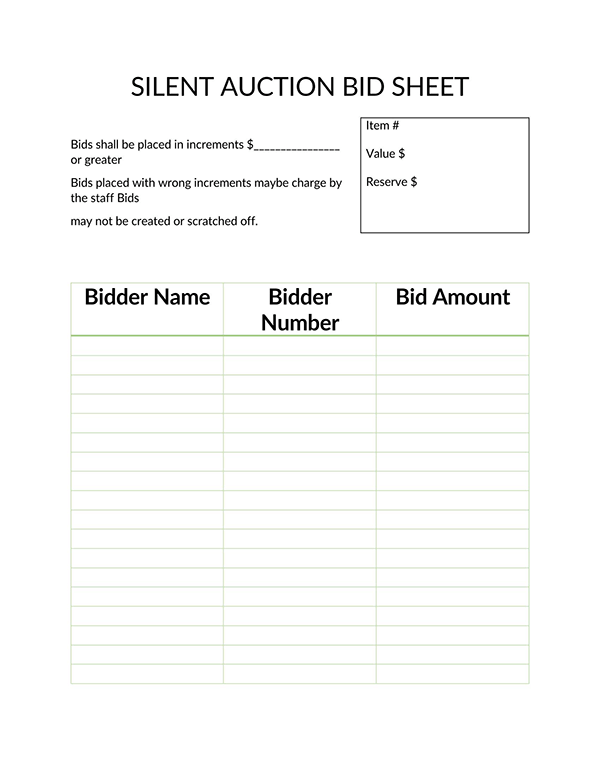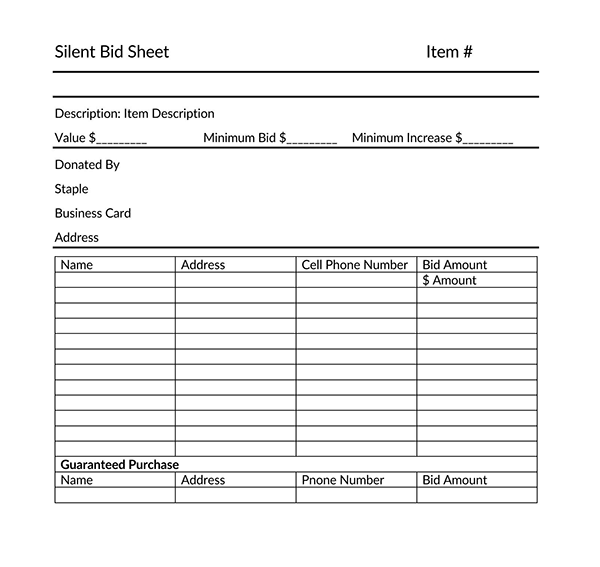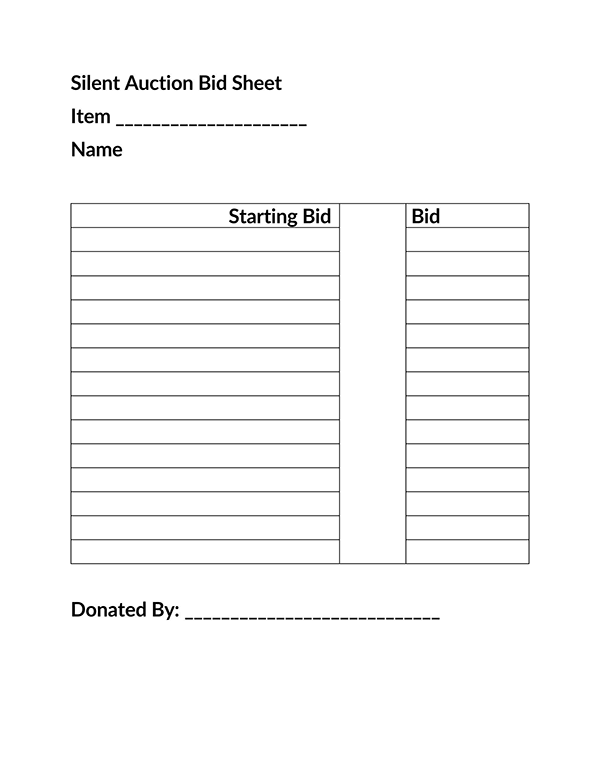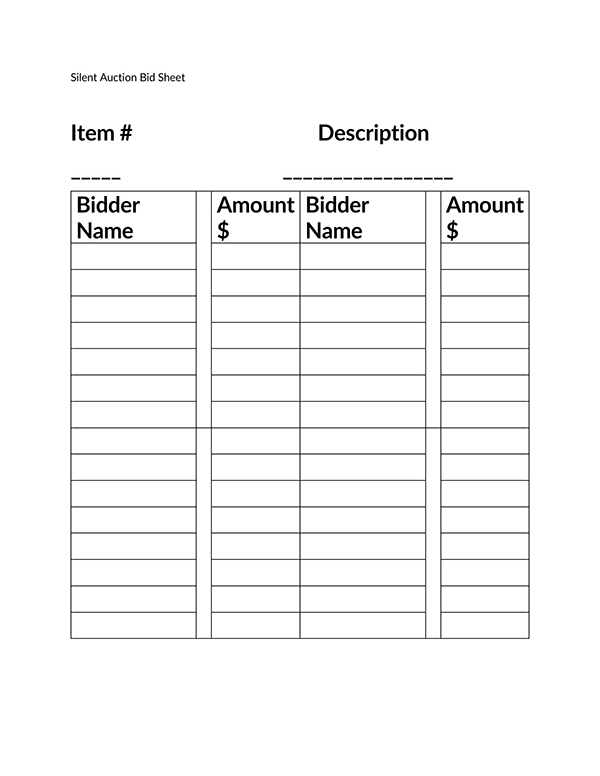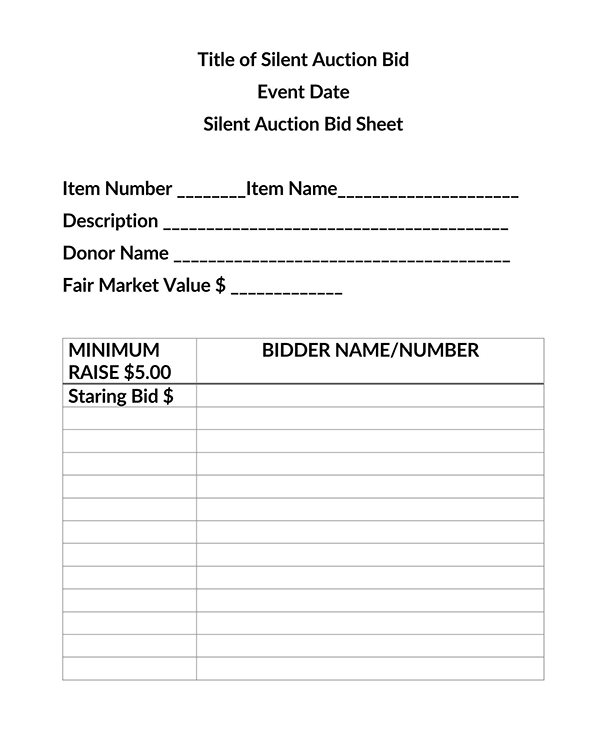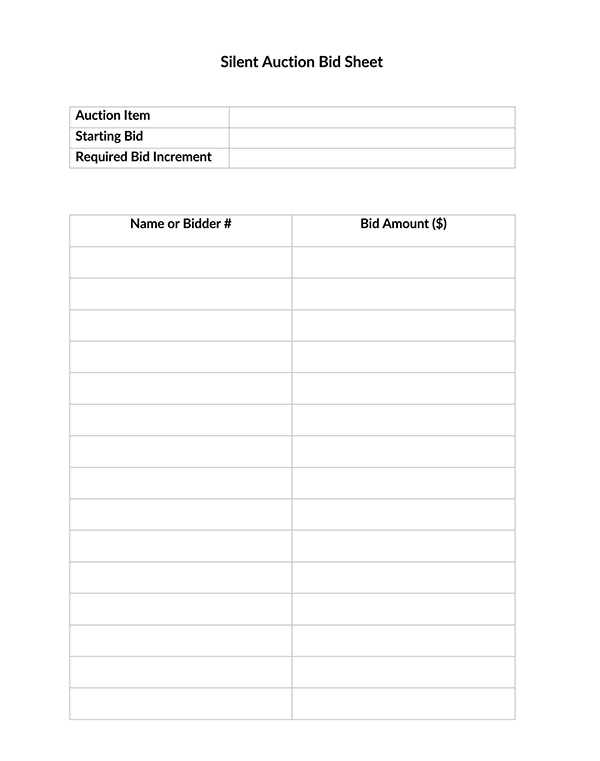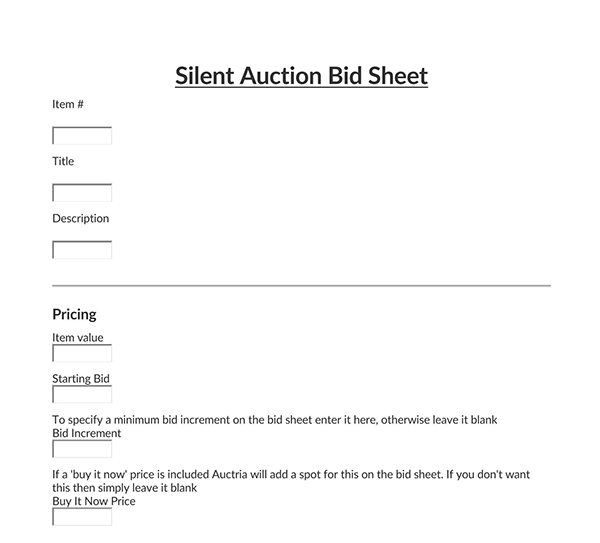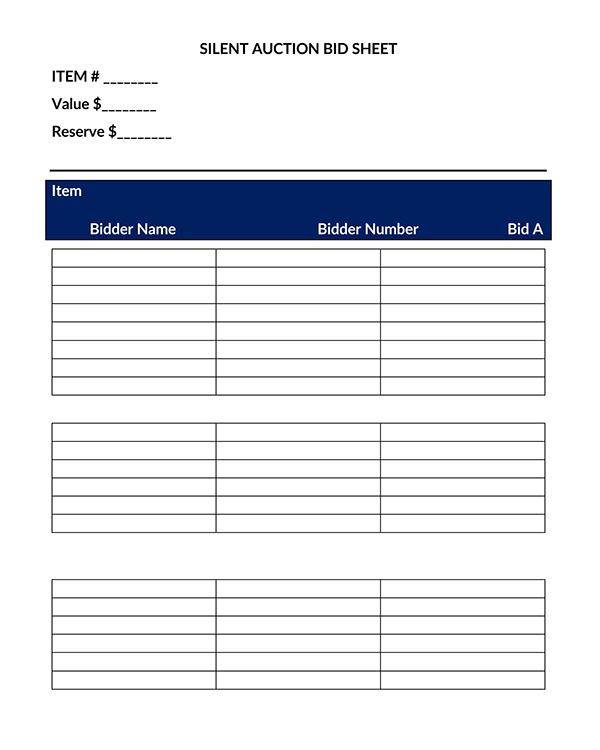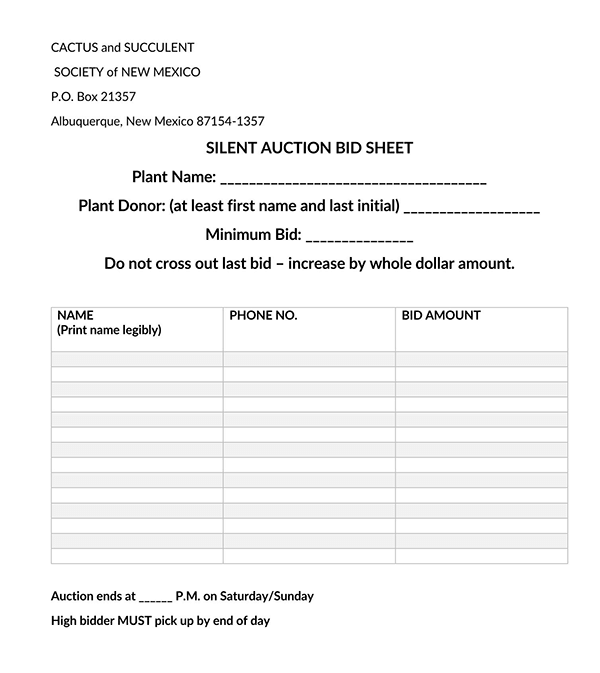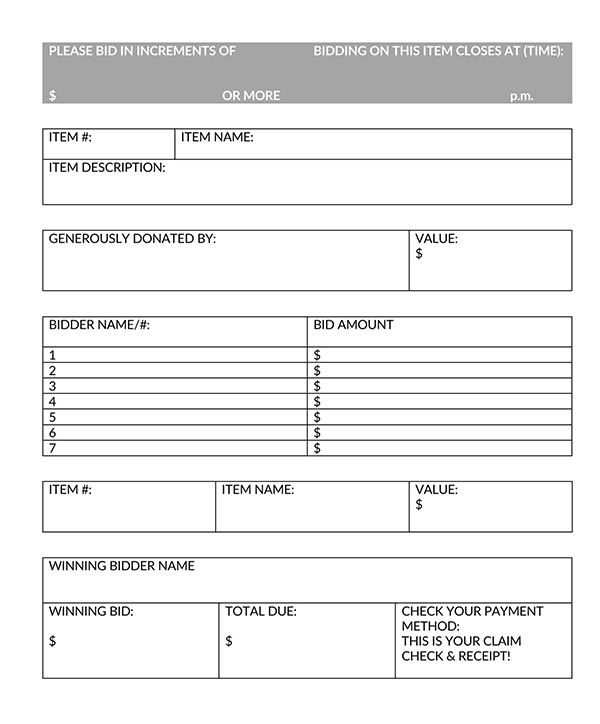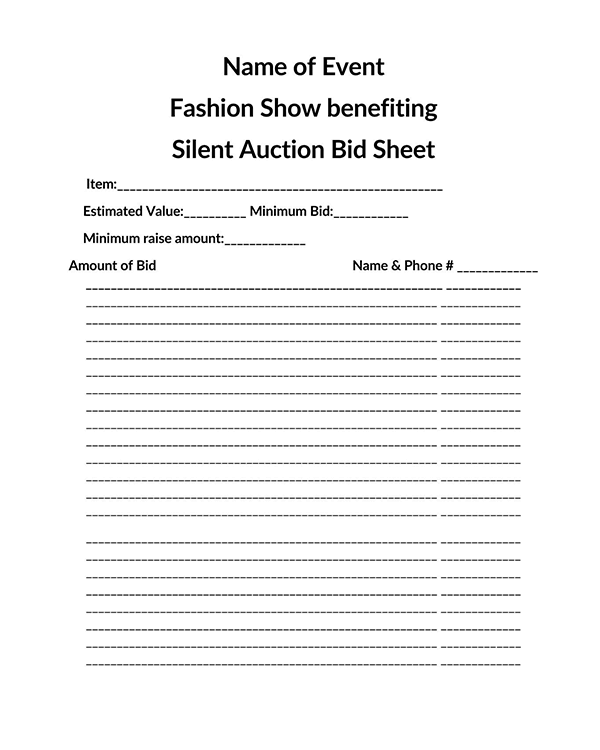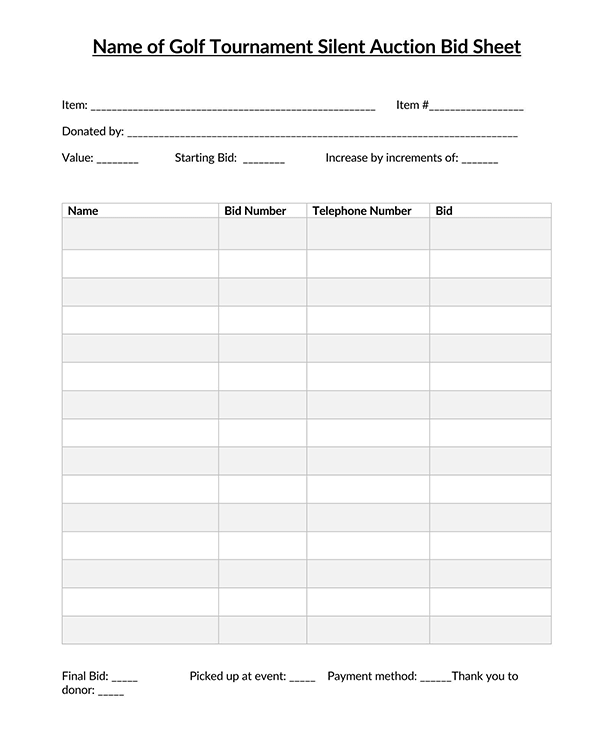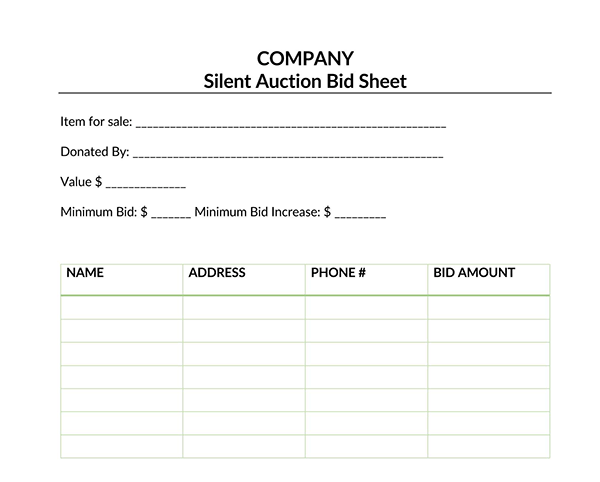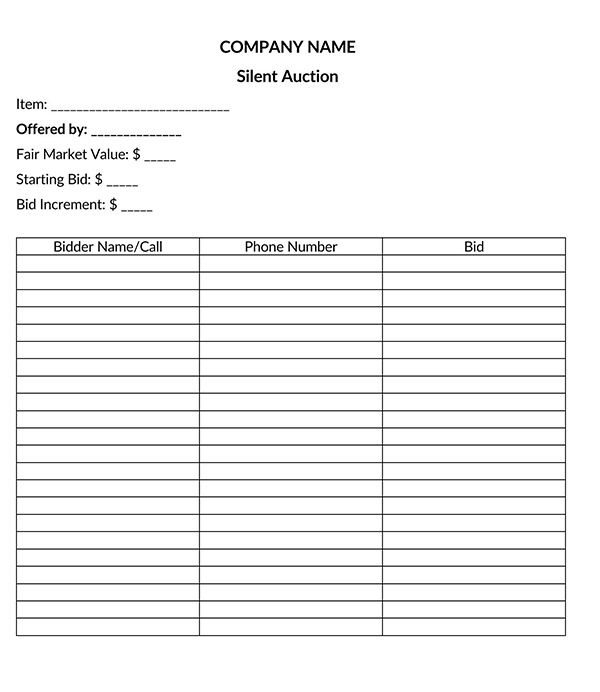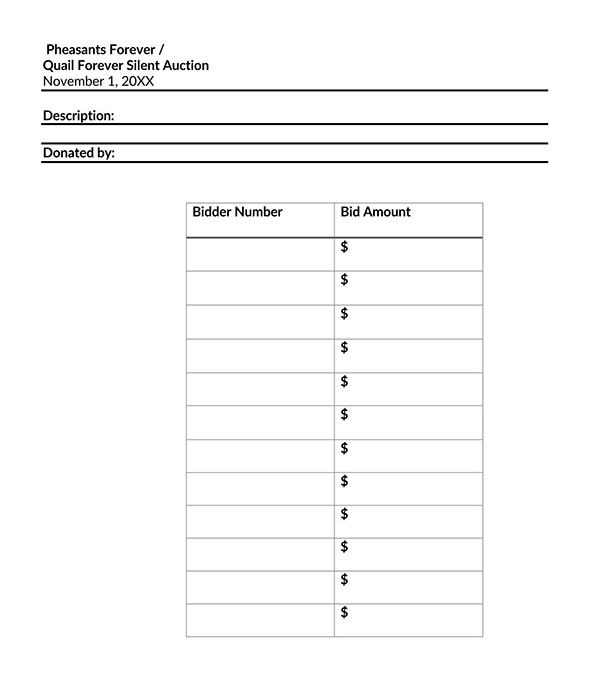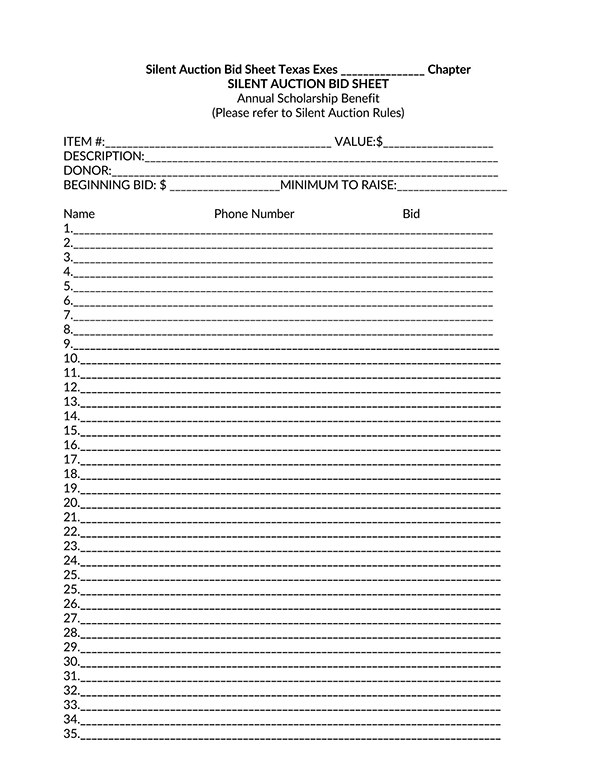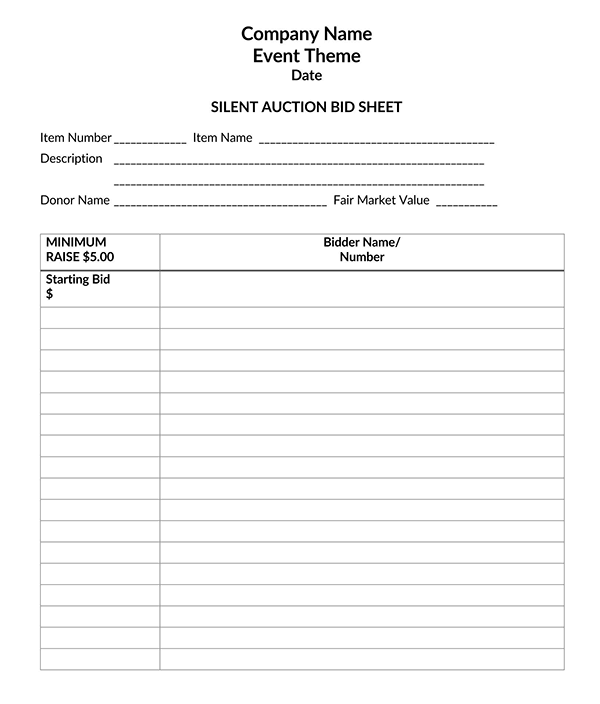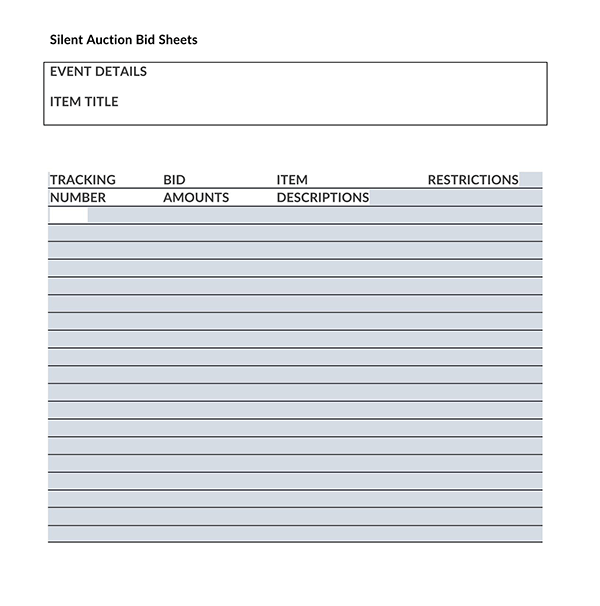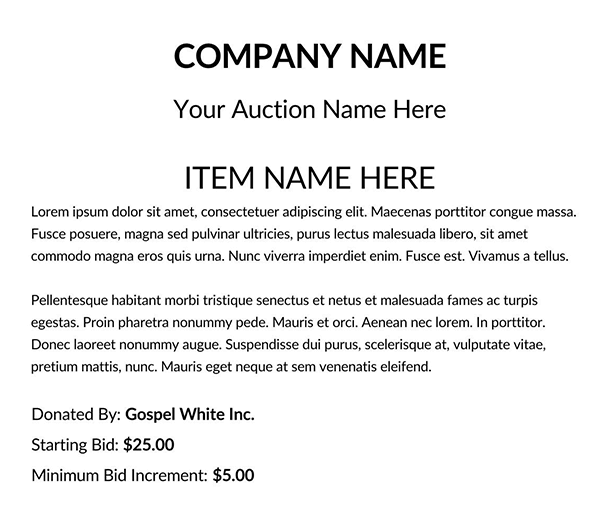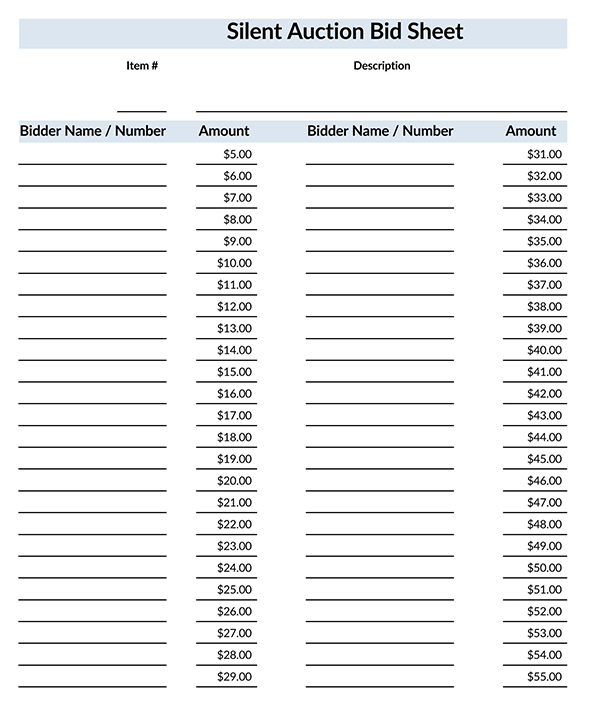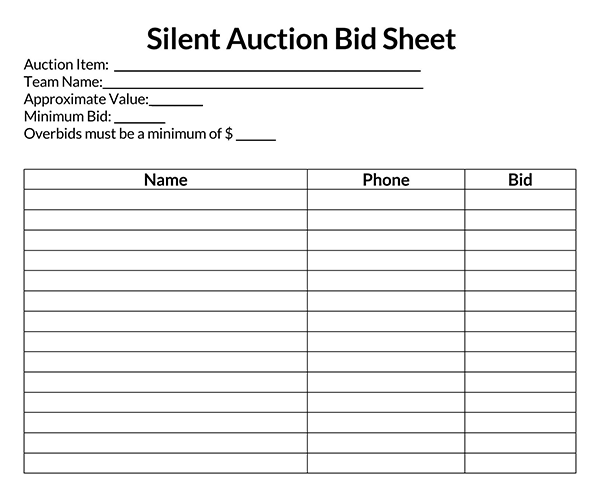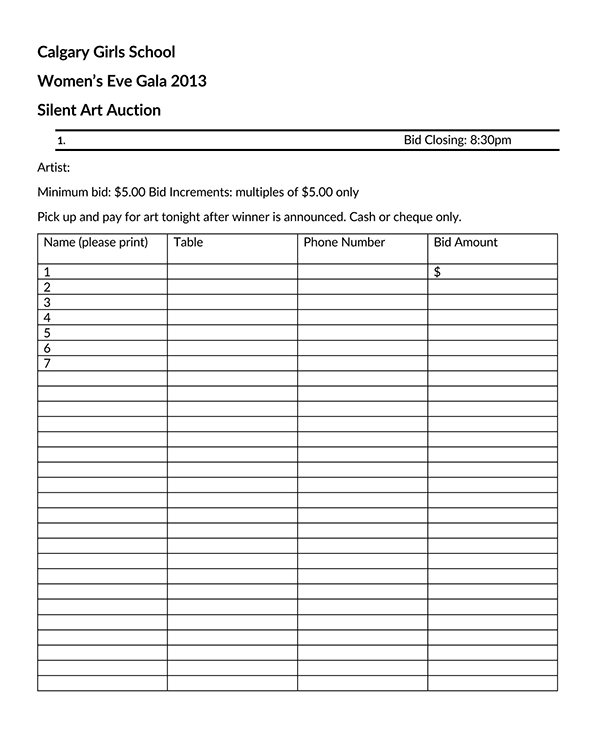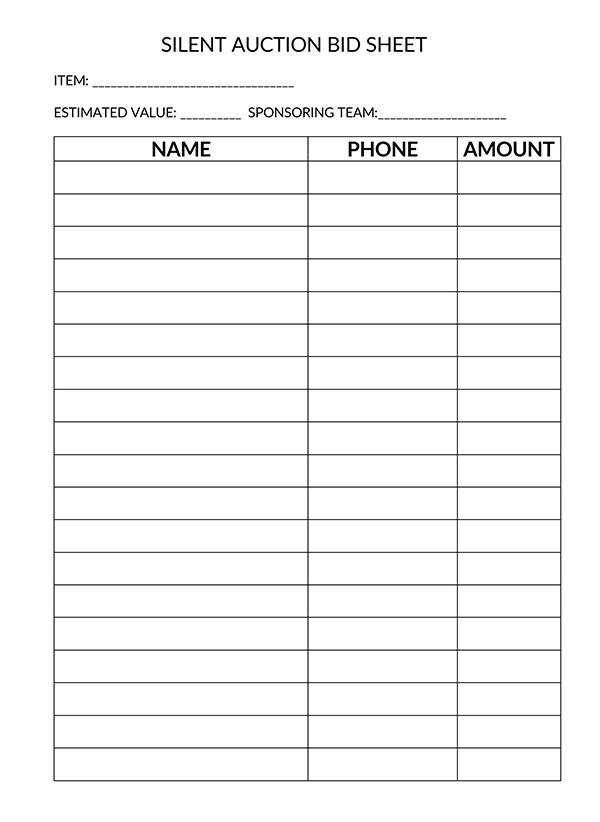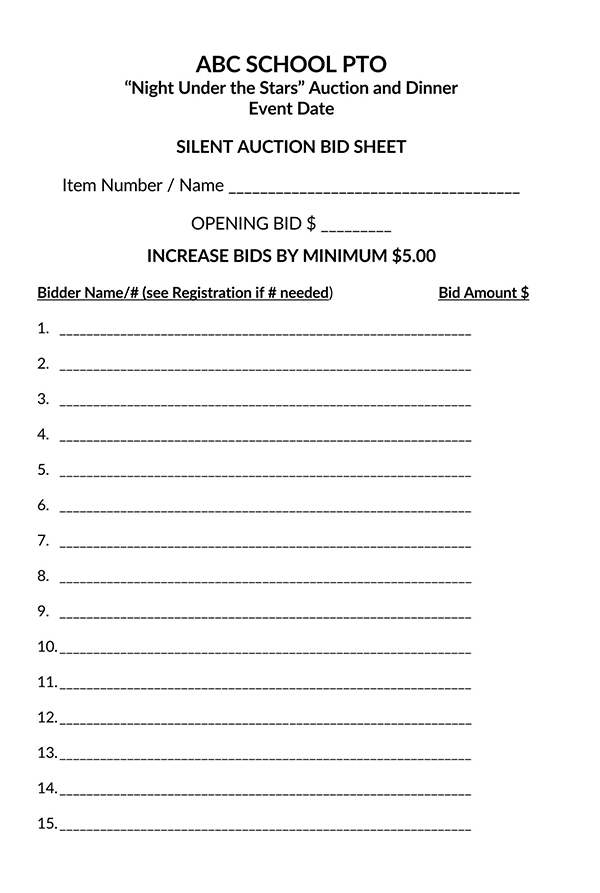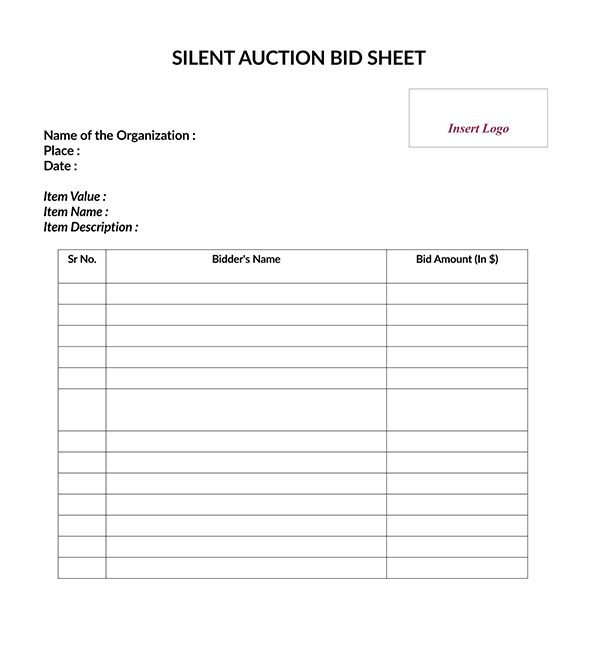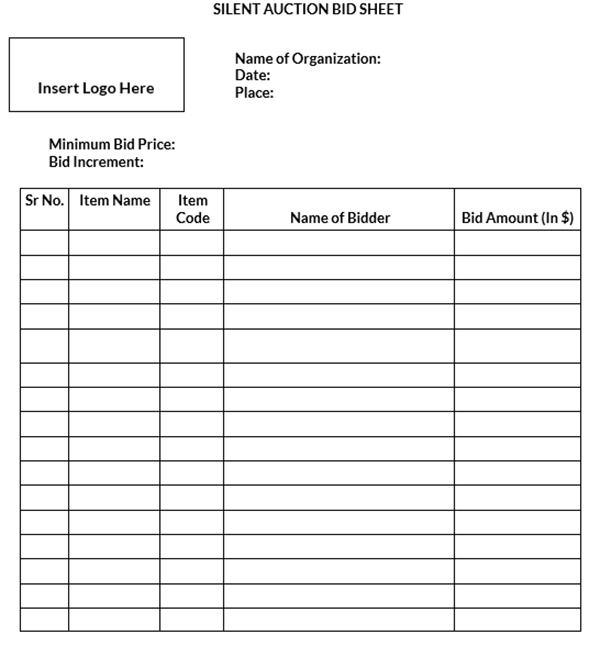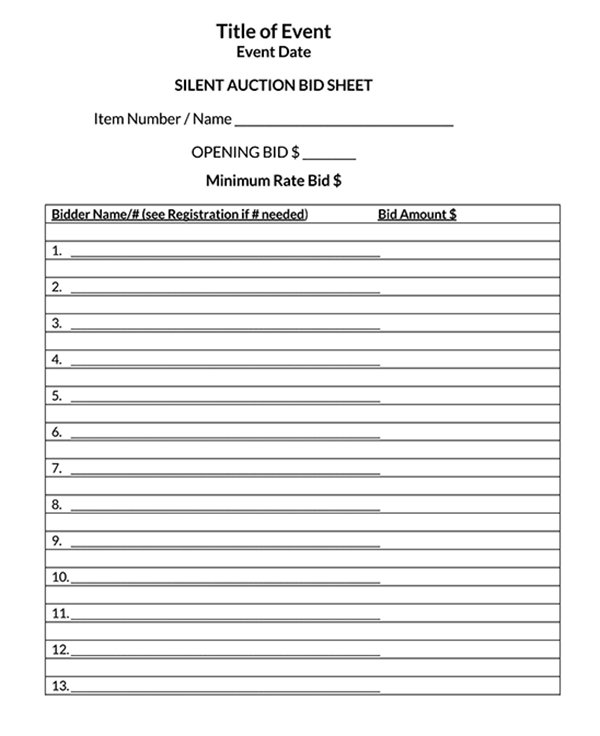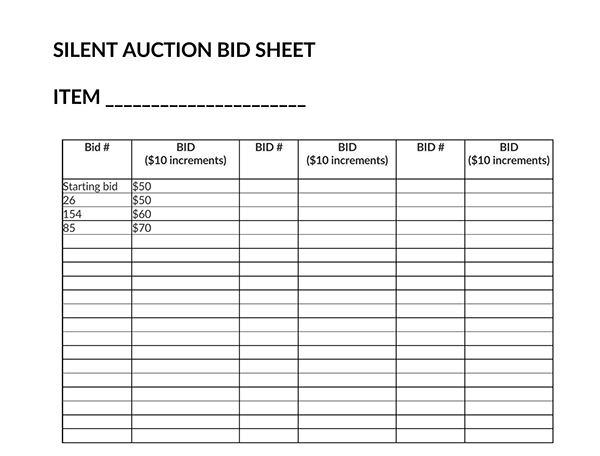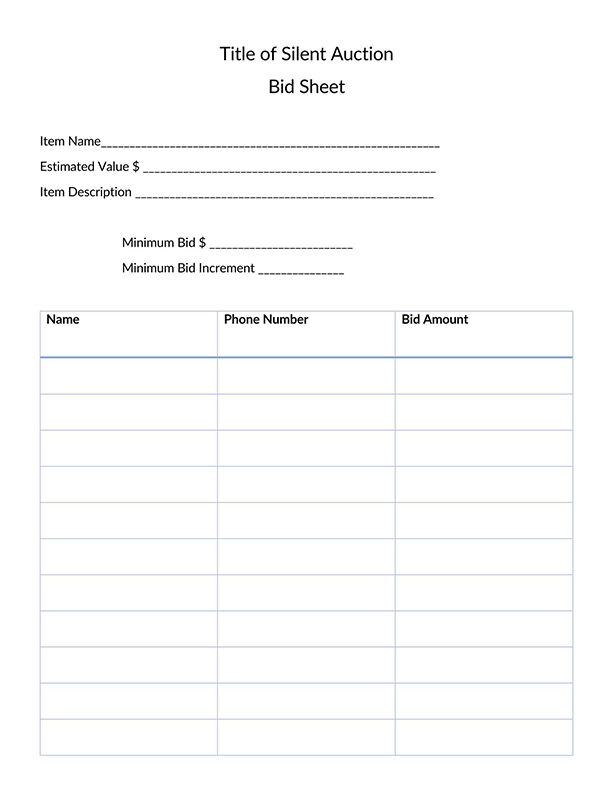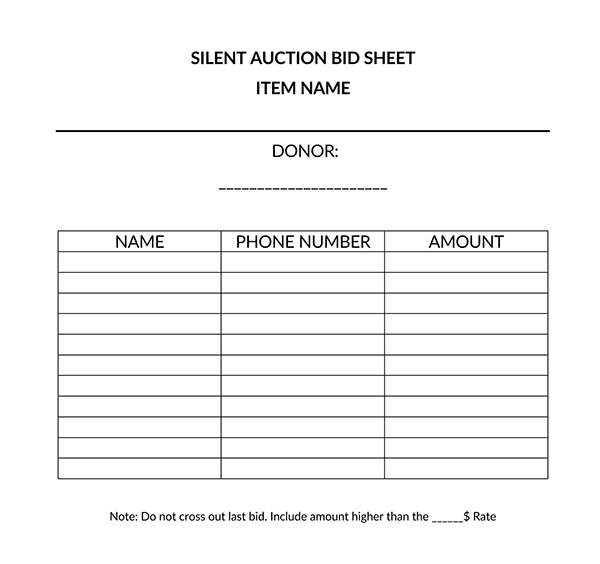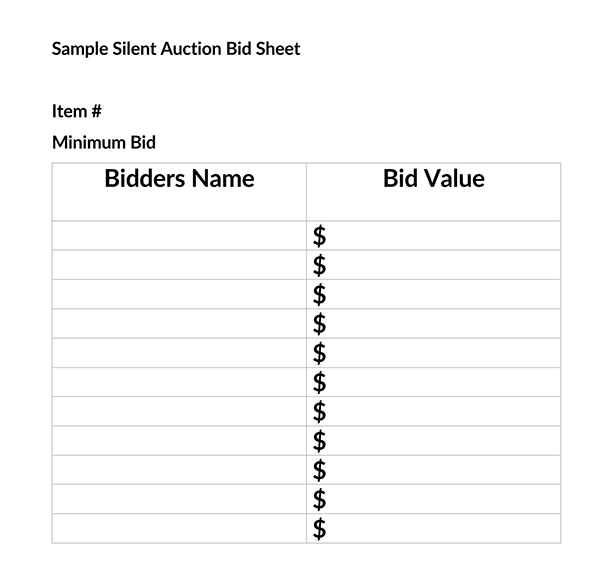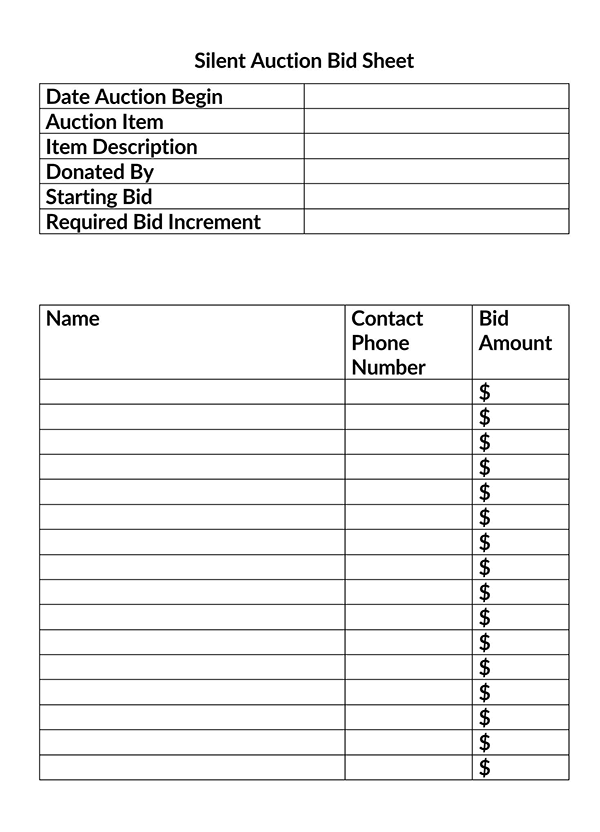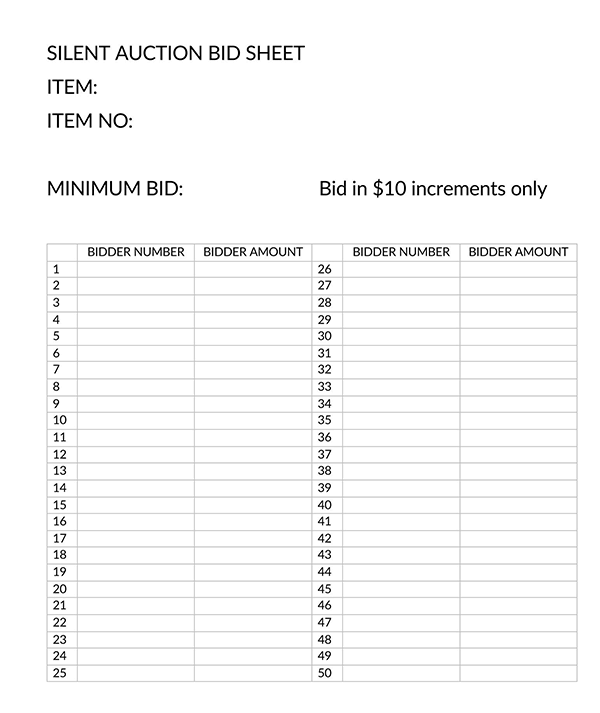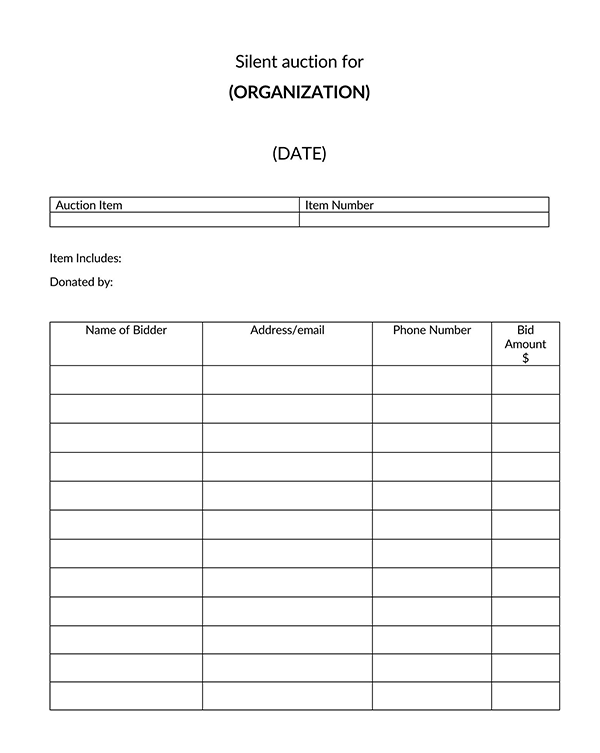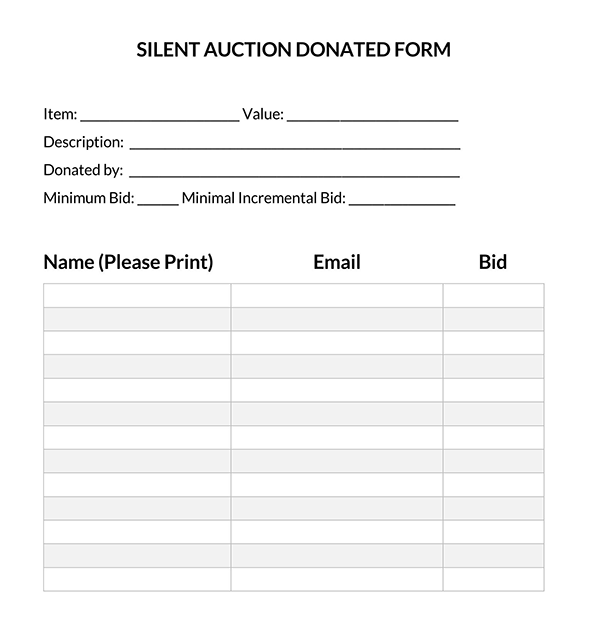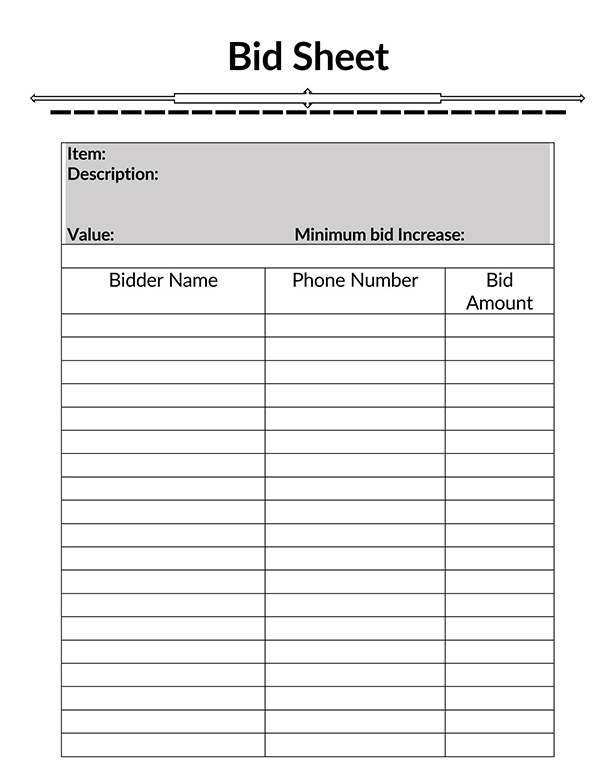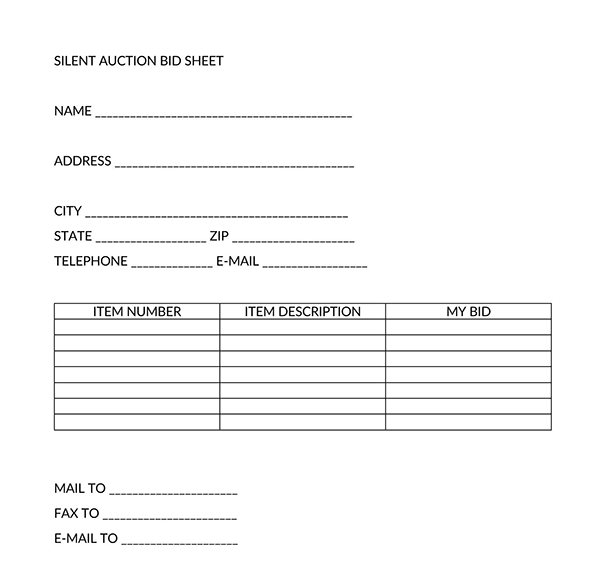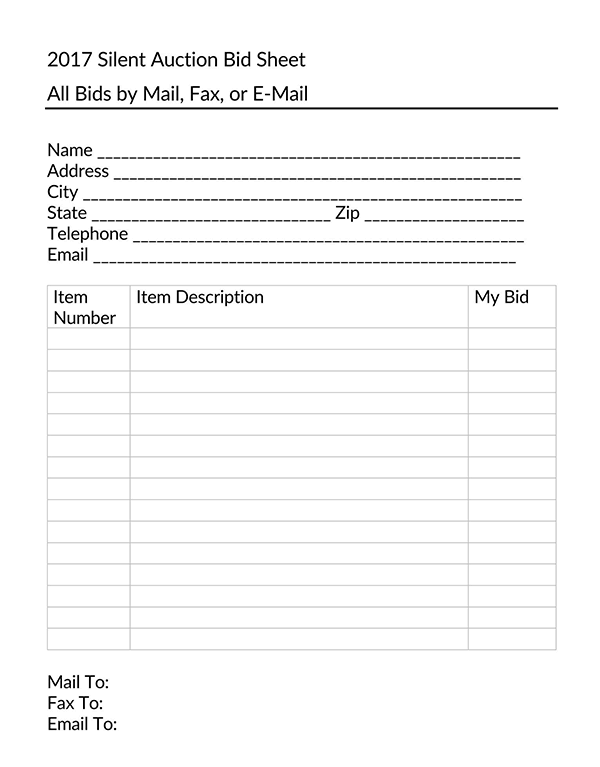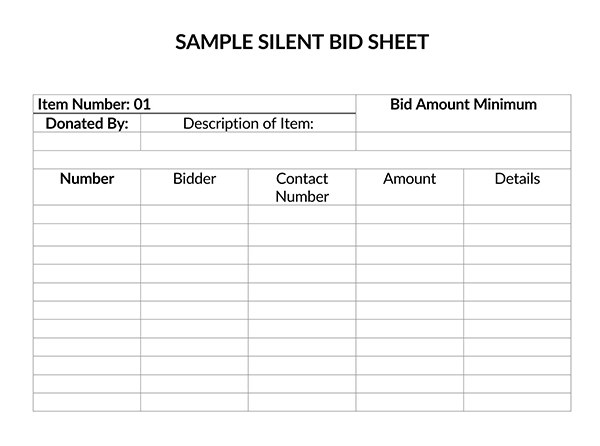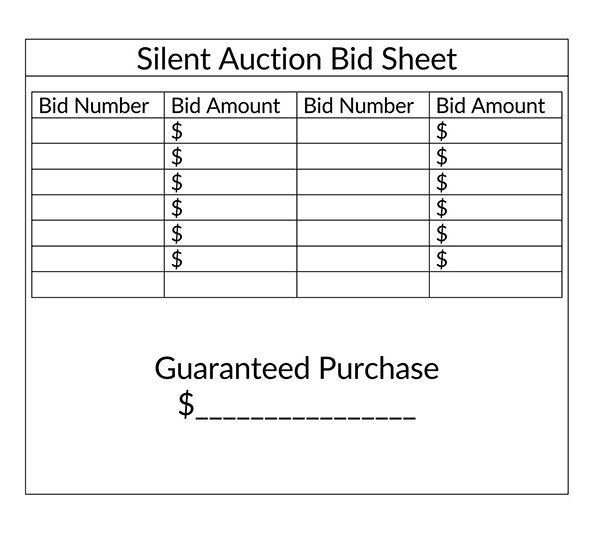A Silent Auction is a charity auction and nonprofit fundraising event held without an auctioneer.
Instead, bidders of a silent auction place their bid secretly in a paper bid sheet or online after assessing /browsing items such as jewelry, art, destination packages, etc. The bidder with the highest bid wins the item. Nonprofit organisations and charities often use a silent auction to raise funds for various causes. Individuals donate auction items to the charity or nonprofit organization that directly earns money for the causes it represents.
Free Bid Sheets
How does a Silent Auction Work?
Unlike a traditional auction, a silent auction is well organized to ensure that bidding runs smoothly. First, the organization carrying out the auction displays the items for participants to inspect. Often an item description is included to encourage attendees to place their bids. Next, each item has a bid sheet where participants /bidders can place their bids. The bids are placed anonymously with a bidder number to hide the identity of a participant.
Participants can return to the bid sheet and up the bid before the auction is closed. Finally, when the bidding is concluded, organizers collect the bid sheets, and the highest bid on each sheet is the winning bid. Individuals with a winning bid number go home with their items.
Nonprofits use silent auctions as a way to raise funds for their charities. The items placed on auction are often donated; therefore, organisers can fully benefit from the silent auction. A silent auction also allows organizers to engage with participants and encourage them to become regular donors for the charity. Silent auctions, therefore, help nonprofit organizations to find new donors.
What are the Components of a Silent Auction Bid Sheet
It is a sheet of paper placed on each auction item where bidders write their bids for an item and a bidder number.
Silent auction organizers use the bidding sheet to track the bids made on each item and identify the winning bidders. Therefore, the bid sheet plays an important role in ensuring the auction runs smoothly.
The components of a silent auction bid sheet will play a major role in ensuring the silent auction runs smoothly, especially since there is no auctioneer. The bid sheet will also help instruct bidders on how bidding occurs.
Therefore, the bid sheet should include the following components:
Bidder name/number
The bidder name /number will help the silent auction organizers identify the winning bidder of each item. This will ensure items go home with the right bidder.
Item number
The organization will be auctioning several items; therefore, linking each item with its bid sheet will help make the process more organized and coordinated. It will also help the bidder identify which item he/she is bidding.
Title and description of the items
The organization should also include the item name/title and a description. This will help encourage the participant to place a bid.
Starting bid
The organization should include the minimum bid amount. This will help prevent valuable items from being auctioned at a lower price than their value. In addition, it will help inform the bidder on where to start his/her bid.
Item value
It is also important for the organization to find out and place the item’s value in the bid sheet. This will help to show the bidder that the item is of value and worth biding.
Minimum raise
The auction bid sheet should contain the minimum amount the bidder can raise. This will help encourage generous bidding, therefore, preventing bidding that only goes up dollar by dollar.
How to Bid on a Silent Auction Bid Sheet?
The silent auction bid sheet is where the actual auction occurs; therefore, both the auction attendees and nonprofit fundraisers must know how to use it. In addition, knowledge of the use of the bid sheet will ensure all parties involved are satisfied with the outcome of the silent auction.
Auction attendees
The auction attendee should start by getting his/her bidding number to protect his/her anonymity throughout the auction and help him /her take part in the auction. He/she should then browse/asses the items to identify which ones he/she would like to have. This will help in focusing on what you want out of the auction.
The auction attendee should follow up by writing his number on the bid sheet to help organizers identify when one wins an auctioned item. Next, the auction attendee should use the minimum increment to calculate the bidding price. This will enable the bidder to come up with a bidding value.
The bidder can then write the bidding price in the bidding price box, which should be monitored throughout the auction to ensure the bid is not outbid. The auction attendee can repeat the bid as needed till the close of the auction. Finally, the bidder should wait to be notified of winning bids at the auction checkout.
Nonprofits: how fundraisers use bid sheets
The nonprofit should start by putting a silent bid auction sheet on each item before opening the auction. Once the auction is open, the nonprofit should encourage attending bidders to make their bids. The volunteers present should monitor the bids made by bidders.
The volunteers will ensure that the bidders are following the start bid and minimum raise rule. They can also answer any questions that the bidders have. Volunteers should disqualify bids if/when needed, especially when the bidder is not following the auction rules. The nonprofit should then give bidders several warnings as closing time for that auction approaches.
note
At least 10 to 5 minutes warning should be provided to enable the bidder to make the last bid for an item.
Next, volunteers should close and collect the bid sheets so no one can slip in a bid after the auction’s closing. The nonprofit must then review the silent auction sheets for each item to identify the winning bidders. Volunteers can circle the winner or draw a line through the vacant spaces of the bid sheet.
The nonprofit should ensure that the winning bid has adhered to the start bid and minimum raise rules. Finally, the items should be assigned to their winning bidders, and the amounts made by the bidder should be calculated.
The nonprofit should provide winning bidders with receipts for the items won to help act as proof that the nonprofit has received the money in exchange for the item. The items must then be delivered to the winning bidders at the checkout to conclude the auction fully.
Bid Sheet Templates
Silent Auction Rules
A nonprofit should ensure that it creates and outlines its silent auction rule. The rules should be easy for the participants to understand and well understood by the volunteers to monitor.
The following are some rules that a nonprofit should consider adding to its silent auction:
Bidder registration rules
The nonprofit should consider creating biding registration rules, preferably through fundraising software. The bidding registration rules should require attendees to read and agree to the rules and regulations set for participation in the silent auction. Written copies of the rules should be provided to all guests to use as a point of reference during the auction. Volunteers present at the silent auction should sufficiently answer any questions posed by bidders.
Auction items rules
Information on an attendee’s right to change an item, the final sale of all items, refunds, and where limits apply should be provided before the start of bidding. This will help prevent disputes about the auction items that may arise due to a lack of knowledge by bidders. This process can be facilitated through mobile bidding as well.
Bidding process rules
Critical rules on the bidding process should be provided by the nonprofit.
EXAMPLE
Rules on the duration of the auction, when the bidder can make the final bid, the minimum bid increments, and information on whether or not a bid can be withdrawn or altered should be provided in the bidding process rules.
Legal restriction rules
Legal restrictions that may apply to the silent auction should be provided. The rules should include the risks and hazards the bidder assumes in participating in the silent auction or attached to the items. This age restriction applies to certain items, which must be specified in detail and the required documentation to purchase age-restricted items. The charity may contact their legal team in case of confusion over legal aspects of items.
Closing bids rules
Rules directing bidders on closing bids should be outlined by the nonprofit. These rules should include information on when bids must come to an end and the criteria used to identify the highest qualifying bid.
Checkout procedures
Rules should be established on the checkout procedures winning bidders can use. Checkout procedures should include information on where the bidder can check out an item when winning items can be picked if the nonprofit is willing to make special arrangements to accommodate bidders who cannot pick their items at the stipulated period, and what will happen to unclaimed items.
Several other rules should be considered:
- Avail an appropriate number of auction items: The ratio of attendees to auction items should be one item to two people to help attendees stay focused in the silent auction.
- Proper traffic control should be implemented: The auction items should be placed in a visibly accessible place to ensure easy and quick follow of traffic in an area. This will provide every bidder with an opportunity to assess the items.
- There should be a strategic organization of items: The organization of items will impact how attendees bid. To encourage multiple binding items should be placed from the least expensive to the most expensive.
How do You Run a Silent Auction?
Proper planning and hosting of a silent auction can ensure that the event is held successfully. Extensive preparation will also ensure that the silent auction has a huge impact on the bidder.
Therefore, when planning a silent auction, a nonprofit should consider the following:
Promotion
The nonprofit should consider promoting the event by creating an effective promotion strategy that will help advertise the silent auction. Marketing tactics like inviting donors via email, sending physical invitations, and sharing posts on social media can be effective.
Venue selection
An appropriate venue where the silent auction can be held should be selected. During venue, selection priority should be placed on the nonprofit’s needs and budget. The venue should have enough capacity to accommodate the guests, volunteers, items on auction, and a serving area for food or drinks if provided. Once a space is selected, it should be booked in advance of the event taking place.
Item selection
The items to be placed on auction should also be considered. This will largely depend on the type of interest the bidders have. The bidders’ age group, level of education, and stature or social standing can have a big impact on the items placed on auction.
Item display
All the selected items should be well laid out in areas where bidders can easily access them for assessment. Suppose there are a lot of items, then creativity should be used in the display.
EXAMPLE
Platforms, stages, or even easels can help with item display.
Item descriptions
The nonprofit should create a detailed item description sheet for each item on auction. The description should include information on what the item is, who donated it, why it is valuable, and any other information that may be of value to the bidder. This will ensure that the bidder cannot claim that he/she was not well informed about the items.
Registration
The nonprofit can opt to register the participants of the silent auction in the planning stage. Each registered participant should be issued a bidder number. Registering participants before the silent auction will help the nonprofit come up with the estimated number of guests coming to the auction.
It will also enable the nonprofit to collect contact information from all attendees. The nonprofit can use this information to get in touch with bidders after the silent auction.
Bid sheets
The bid sheets should also be created with all the necessary components to help guide the participant or bidder through the silent auction. Adequate copies of the bid sheet should be made to ensure there is no shortage.
Volunteers
The nonprofit should recruit an adequate number of volunteers to help in the setup and running of the auction. The volunteers should be educated on the items on auction to ensure they can answer any questions posed to them by bidders. They can also help carry out responsibilities like registering the attendees, check-in, checkout, and other duties the nonprofit may require them to carry out.
Auction monitors
The nonprofit can opt to have experienced auction monitors who will be responsible for ensuring that all the rules and guidelines of the silent auction are adhered to by the attendees. They help make it easy for fair bidding to take place.
Checkout area
A checkout area should be designated for winning bidders to claim their items and pay for them. Delays at this point can irritate winning bidders who are excited to receive their items.
Do’s and Don’ts of Silent Auction
A nonprofit should consider some of the dos and don’ts of a silent auction during the planning and execution stages. Making these considerations will help ease the bidding process and will provide favourable results.
The following are the dos and don’ts of a silent auction:
Some of these dos are:
- Do recruit your best volunteers: The nonprofit should recruit its best volunteers to help set up the silent auction and help ensure that it runs smoothly. Previous donors, past volunteers, board members, or ambassadors may be considered among the best volunteers that a nonprofit should consider.
- Do organize your items by section: It will be best to ensure that the items on auction are organized by section. This will ensure easy navigation of the venue where the silent auction is held. The bidder will also be able to quickly identify a section of interest. Organizing the items by section also helps show the bidder that the nonprofit carries out its operations in a well thought out organized manner.
- Do ensure your silent auction items will be profitable: The nonprofit should ensure that the items placed on auctions will be profitable. This can be achieved by ensuring that the items on auction are of interest to the participants, finding out the fair market value of each item, stating a starting bid for each item on the bid sheet, and indicating a minimum rise/increment in the auction bid sheet. Profitable items help increase the revenue from the silent auction, which is beneficial for the nonprofit.
Some of these don’ts are:
- Don’t forget to follow up: Even after the silent auction is over, the nonprofit should follow up and thank the attendees for their support. Thank you notes should be sent to sponsors, donors, volunteers, staff, and attendees.
This is a polite gesture that will make all parties involved in the auction feel appreciated. It will also encourage them to take part in future silent auctions held by the nonprofit. - Don’t use paper bid sheets: Paper bid sheets can pose a range of challenges. For example, errors can be made when manually entering a bid. Such a mistake can be difficult to deal with. Illegible entries can also pose a challenge, especially when trying to identify if the bid is the winning bid or not. Mobile bidding can help eliminate some of these challenges.
- Don’t over-procure silent auction items: The nonprofit should avoid over procuring silent auction items as this can decrease the number of bids made due to overwhelming the donors, and therefore impacting the profitability of the silent auction for the nonprofit. This will ensure that the nonprofit does not remain with leftover auction items.
Online Silent Auction
A nonprofit should consider running an online silent auction. An online silent auction can be achieved by using a carefully selected and preferred auction software or app. This will ease the registration of participants, the bidding process, and the payment of auction items.
An online auction will relieve the nonprofit from having to find a sizable venue that can accommodate a certain number of guests. The online auction can increase the number of participants that can access the silent auction. When carrying out an online auction, the nonprofit’s only concern is soliciting items, photographing them, displaying them, and setting a starting bid.
An online auction can also allow for a longer auction period than would otherwise not be the case with an in-person auction. Auctions can run for days or even weeks; therefore, bidders will have an opportunity to participate whenever they can. A longer silent auction will also increase a participant’s chances of placing the final winning bid.
Advantages of Online Bidding
There are server advantages associated with online bidding that a nonprofit can utilize. Mobile biding should be a top consideration of nonprofit planning on running a silent auction.
The following are the advantages of mobile bidding:
Mobility
Online biding reduces the bidder’s movements by helping to place bids without any physical commute. As a result, the bidding process is made less exhausting, creating a better experience for the bidder who can now socialize and participate in other fundraising activities.
Outbid notifications
Outbid notification can help bidders keep track of bids made on an item they are interested in without having to constantly check the bid sheet. This will enable them to quickly place an even higher bid to increase their chances of getting the auctioned item.
Countdowns
online bidding enables a nonprofit to set an automated countdown that reminds bidders of their bidding items. This will increase the revenue earned by the nonprofit as bidders can bid for an item throughout the auction till closing.
Auction control
Mobile bidding provides a nonprofit with easy auction control.
EXAMPLE
The nonprofit can present the opening and closing time 5 seconds before the auction starts.
This will ensure smooth running by reducing or eliminating the chaos brought about by a hands-on silent auction.
Remote bidding
A major benefit of online bidding is remote bidding for participants who cannot physically attend the silent auction. This helps open new revenue streams for the nonprofit by making bidding easy and more inclusive.
Shorter registration and checkout lines
The time taken to register and checkout into a silent auction is significantly reduced when using online bidding. The nonprofit can have a central place where the biding data is collected, making the process speedy and convenient even for the bidders/participants.
Auction close and checkout
The closing and checkout are relatively easy, where mobile bidding is used to run a silent auction. Mobile bidding software can automatically identify the highest bidder of each item and notify the winning bidder via text easing and speeding up this process.
Frequently Asked Questions
The number of items featured in the auction will depend on the number of guests expected by the nonprofit. If the items outnumber the guests by a ratio of 2.5 to 1, then too many items may not reach their bidding potential.
Each guest should have a ratio of 1to 2 items with the upper limit as 3items. When there are too many items, the nonprofit can consider bundling the items together to be bid on as a pair or holding a prior online auction to reduce the number of auction items before the silent auction event.
The nonprofit should aim for each silent section to have at least 35 items. The greatest number of items a silent section can have is 50 anything above that will overwhelm the bidder preventing him/her from fully taking in the items on display.
This will depend on the number of silent auction items a nonprofit has. The more the auction items, the more silent auction sections are required by the nonprofit. However, even when a nonprofit has a few items but decides to place fewer items than the standard 35-50 items per section, the result is an increase in the number of silent action sections required.
